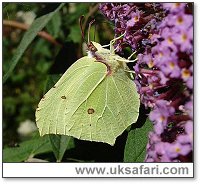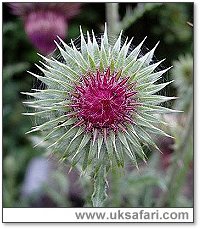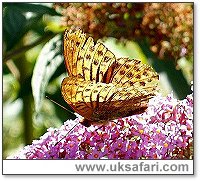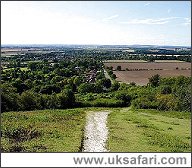
|

|
|
 Sent
to you Sent
to you
by e-mail
|
|
Simply
enter your details and hit the send button
more
info |
|


Click Here

Links
Advertise
Terms of Use
Contributors
About Us
Contact Us
|
 |
Go back
 | Bookmark
| Bookmark
 | Print Page
| Print Page  | E-Mail Us
| E-Mail Us 
 Butterfly Safari in the Chilterns
Butterfly Safari in the Chilterns
by Dean Stables
|

Brimstone Butterfly
|
|
UK
Safari Tip:
An ideal way to catch and observe butterflies without harming them is with
a special butterfly net - click here
|
|
I'd been contacted by a fellow photographer, asking if I'd like to take a trip to the Bucks/Oxford area on the 7th August
2004 in search of 3 Butterfly species; Silver-washed Fritillary, Silver-spotted Skipper and Brown Hairstreak.
Never one to miss a day out photographing wildlife I jumped at the chance.
The day arrived and we proceeded to make our way south from Yorkshire down the M1. All was going well
until we approached junction 13, where the traffic was at a standstill. A quick tuning of the car radio told us that a French lorry carrying barrels of bitumen had caught fire just before junction 11 and as a result the fire had spread to the motorway surface. Imagine our despair, when they added that the motorway in that area would most probably have to be resurfaced.
Ah, the joy of British roads. It was obvious that we weren't going anywhere for some time.
Being one of the hottest days of the year, the outside temperature was beginning to rise dramatically and we couldn't think of anything worse than being in a stationary car. It wasn't long before people became frustrated by what was going on, and it was a most unusual sight to see people walking their dogs, riding bicycles and even setting up picnic tables at the side of the motorway.
Anyway, 6 miles and 4 hours later, we were finally off the motorway and on our way to the first site at Wendover Wood, situated several
miles Southwest of Tring. On arrival at this site, I was surprised to see how much Wild Marjoram there was, and how many Gatekeeper butterflies were feeding from this plant. In amongst the Wild Marjoram were quite a few stands of Welted Thistle (one of my favourite thistles) with its spider-like silk that surrounds the rosette.
|

Welted Thistle
|
We eventually came to a clearing that had a small Buddleia bush. We'd been told this particular bush was attracting several species of butterflies and true to form, right in front of us were our very first Silver-washed Fritillaries.
|

Silver-washed Fritillary
|
Although they were very worn, it didn't dampen our excitement of seeing a new species. They were however very difficult to photograph, as they were continuously moving round the flower spikes.
Also in amongst the commoner species, namely Large and Small Whites, was a cracking, and very obliging male Brimstone. I also spotted my first ever Marbled Whites. There were three in total, again difficult to photograph.
|

Halfway up Watlington Hill
|
After several minutes we were very pleased with the total of 6 Silver-washed Fritillaries and decided to make our way to the next site at Watlington Hill, the most northerly location in Britain for our next species.
Watlington Hill is a steep south facing chalk hill that lies about 14 miles Southeast of Oxford. Again at this site the dominant plant was Wild Marjoram, but somewhat smaller than at
Wendover, due to the very
thin soil. It was a tiring climb up the hill, not helped by the baking temperatures, but we were rewarded with our second target species, the Silver-spotted Skipper. Although there were a least 30 individuals, these proved impossible to photograph. As soon as you got within shooting distance of one, it took off in a very fast moth-like flight.
It was at this site that I added another 2 new species to my days tally; a Lesser Treble-bar moth, and a Brown Argus
butterfly. I never realised just how small this butterfly actually is. All the time we were watching the butterflies, we had the added
entertainment of at least seven Red Kites flying overhead. Judging by the amount of Rabbit holes in evidence this must be a good hunting area for them.
By this time it was getting late and we decided not to try for our 3rd Target species, the Brown Hairstreak, which had been recorded in woodland between
Horton-cum-Studley and Murcott just Northeast of Oxford. It had an
enjoyable day, and had it not been for the earlier incident on the motorway, we'd have
had ample time to visit this site... but there's always next year.

UK Safari Butterfly Section
|
 |

|